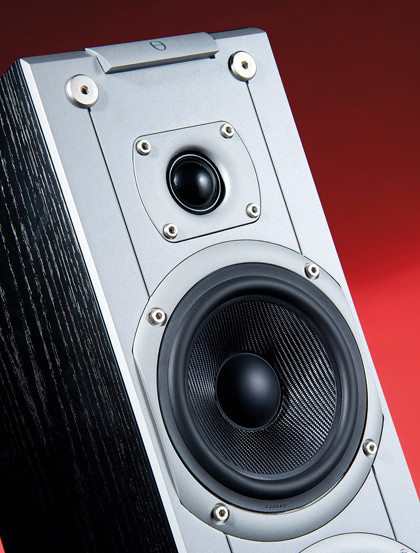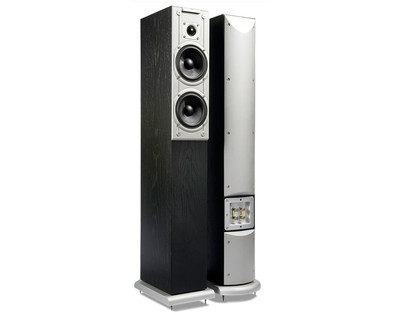TechRadar Verdict
Pros
- +
Smooth, forward balance
- +
Clean, taut bass
Cons
- -
Lacks some weight and dynamic expression
- -
Can become aggressive at high levels
Why you can trust TechRadar
The Ki-series is relatively new and also relatively inexpensive by Audiovector's standards. The Ki 3 Signature are the sole floorstanding models in a range that also includes a standmount and home cinema oriented variations.
But each Ki-series model comes in three versions – Standard, Super and Signature – with superior engineering features as one moves up the ladder.
We've chosen for this review the £1,890 per pair top-of-the-ladder Ki 3 Signature, but a key Audiovector feature is the option to upgrade from the base model to those higher up the hierarchy.
Unconventional performer
All three Ki 3 variations share the same basics, which are themselves somewhat unconventional. The unique upgradeability has already been mentioned, but no less interesting (if a little more common) is the quarter-wave bass loading this model uses.
It's a relatively unusual technique that has something in common with tuned-column and transmission-line loadings, but in this case the shape of the tapered column behind the drivers leans significantly towards horn-loading. A handful of speaker companies have adopted this approach in recent years, the most prominent being Castle Acoustics with its 'twin pipe' models.
The Ki 3s have just the one internal quarter-wave column, which forms a V at the bottom front edge and is created by a partition set at a narrow angle so that it stops well short of the top and roughly bisects the depth. The partition, therefore, creates a rather narrow horn behind the two bass/mid drivers, with a very small 'slot mouth' created between the enclosure base and the plinth.
Three driver two-way
The two identical main drivers are 130mm units, allowing the enclosure to have an exceptionally slim front view. They operate in tandem right up to the 3.2kHz crossover point and feature 90mm diaphragms made from a woven mix of glass and carbon fibres, impregnated, sealed (and damped) within a polymer matrix.

The tweeter has a transparent 25mm woven fabric done, driven from a neodymium magnet with high-viscosity ferro-fluid damping. This Signature version exclusively uses rubber grommets in the mounting to isolate it mechanically from the cabinet above 2.5kHz.
The crossover network is a deliberately simple, minimalist affair, as care is taken to optimise the drivers to make this possible. It's fed from twin terminal pairs, permitting bi-wiring connection or bi-amp drive.
The enclosures are nicely finished in a choice of four real-wood veneers (cherry, black ash, rosewood and maple) – a silk white paint finish is available at extra cost.
Besides the decoupling tweeter mounting, the other feature exclusive to the Signature Ki 3 is a so-called Superstand – a neat, if rather small plinth. Nicely shaped and finished in silver, it does extend the stability footprint a little. Crucially, however, it incorporates a leaf spring in the fixing for the front spikes, so mechanically decoupling the speaker from the floor.
Another feature, this time shared with the Super version, is extra reinforcement for the front and back panels. The top half of the front panel, where the drivers are mounted, is laminated with an extra silver-painted panel 8mm thick; the back is laminated by a shaped and much thicker (up to 24mm maximum) panel, again painted silver but extending the full height of the enclosure.
Needing some space
The Ki 3 came with the confident recommendation that it should be used fairly close to a wall, in order to provide some mid-bass reinforcement. This didn't entirely correlate with our far-field in-room averaged response measurements, which indicated that free space actually gave a marginally flatter overall response.
However, wall reinforcement only showed a mild excess and was actually preferred subjectively. That's probably because the quarter-wave loading seems to be inherently less resonant than the more common reflex ported approach – it certainly sounds that way. Best subjective results under our conditions were obtained with the backs of the speakers about 30mm out from the wall.
The main driving system comprised a Naim NAC552 preamp with NAP500 and NAP135 power amplifiers, driven from Naim CDS3/555PS and Rega Valve Isis CD players, as well as a Magnum Dynalab MD106T FM tuner. Vinyl record players included a Linn/Rega hybrid using a Soundsmith Strain Gauge cartridge. Cables were from Naim, Phonosophie, The Chord Company, TM Systems and Vertex AQ.
Smooth operator
First impressions did reveal some limitations, in both bass weight and dynamic expression. But this speaker also shows a smooth and even overall balance, a wide dynamic range and good basic coherence.
Stereo imaging is particularly good, with very little evidence of boxy effects, and very fine central focus. Furthermore, while the bass might lack some ultimate weight and scale, it does possess the liveliness and clean, crisp character associated with quarter-wave loading, which is musically more useful.
According to the designer, the Ki 3s were designed: "to be used as both traditional hi-fi speakers and as party speakers," and they were equally at home with heavy electronic stuff and more familiar material from English-speaking bands like Tool, System of a Down and Audioslave.
While the Ki 3 shows good loudness capability and handles plenty of power without distress, its mild upper-mid forwardness is happier operating at low and medium volume levels than playing appropriately heavy material at 'party' levels. It can certainly do the latter, but the consequences tend to be an aggressive rather than a comfortable experience.

This is a speaker that does a very good job of disappearing, sonically speaking. It might have certain limitations in terms of dynamic vigour, and doesn't really offer the grip and tension one might find with a larger speaker. It could also do with a little more sweetness and transparency at the top end of the band, but the good enclosure control means that the actual dynamic range and coloration levels are both low.
On balance, Audiovector's Ki 3 is rather impressive. Its super-slim front and suggested near-to-wall location certainly makes it a very attractive and discreet package. The taut, tight and clean bass is a particular joy, underpinning a generally smooth, if somewhat forward tonal balance.
The sound is basically free from coloration, with fine stereo imaging. The only significant criticisms are that the sound is a little small in terms of weight and dynamic expression and can become aggressive when playing at high levels. And a somewhat larger plinth would certainly improve the overall physical stability.
Follow TechRadar Reviews on Twitter: http://twitter.com/techradarreview
